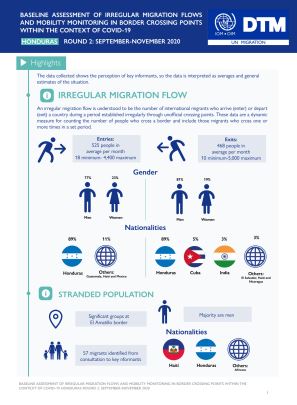-
Countries
-
Data and Analysis
-
Special Focus
-
Crisis Responses
Honduras-Baseline assessment of migration flows and mobiity tracking within the context of COVID-19 report #2 (September-November, 2020)

Contacter
Melanie Gomez magomez@iom.int
Langue
English
Emplacement
Honduras
Période couverte
Sep 01 2020
Nov 30 2020
Activité
- Flow Monitoring Survey
- Flow Monitoring
- Migrants presence
- Mobility Tracking
- Baseline Assessment
- Event Tracking
Due to the alarming levels of propagation and the serious nature of the COVID-19 virus, on 11 March 2020, the OMS declared the State of Pandemic. On the same date, Honduras confirmed its first two cases of COVID-19. During the first weeks of March the Government of Honduras began taking measures to control the propagation of the virus within the country.
In the context of the pandemic, economic activities have gradually reopened through phases, reaching phase 2 during the reporting period. Movement is regulated by a curfew, and traffic schedules have been varied, ranging from 5:00 am to 11:00 pm. The national circulation schedule is also maintained according to the digits of the personal identification number.
In September 2020, the borders were reopened, allowing the entry of people of different nationalities into Honduran territory. Biosecurity measures are maintained and it is stipulated that each person wishing to enter must have a PCR test (with a cost between $50 a $100) of at least 72 hours or a rapid diagnostic test –PDR- (mainly for returned migrant population).
During November, Honduras was heavily impacted by Hurricanes Eta and Iota. At least 4 million people were directly and indirectly affected. 562,274 people were evacuated and around 95,000 were temporarily sheltered. About 70 per cent of staple grain crops were devastated and around 318,635 hectares of agricultural land and were destroyed. Most of those affected were small- and medium-scale producers.
At the end of September 2020, a caravan of migrants formed, creating a massive migration flow that led to a migration crisis. The call reached at least 4,000 migrants who crossed the border with Guatemala irregularly.
